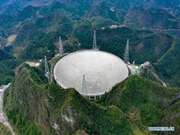

 |
| Photo taken on Aug. 27, 2019 shows China's Five-hundred-meter Aperture Spherical radio Telescope (FAST) in southwest China's Guizhou Province. China's FAST, the world's largest single-dish radio telescope, will greet the third anniversary of operation that began in September 2016. (Xinhua/Ou Dongqu) |
Chinese astronomers have detected repeated fast radio bursts (FRB) - mysterious signals believed to be from a source about 3 billion light years from Earth - with the largest and most sensitive radio telescope ever built.
Scientists detected the signals with the Five-hundred-meter Aperture Spherical Radio Telescope (FAST) and they are carefully cross-checking and processing them, according to researchers at the National Astronomical Observatories of the Chinese Academy of Sciences (NAOC).
FRBs are the brightest bursts known in the universe. They are called "fast" because these blips are very short, only several milliseconds in duration. But there is no reasonable explanation for their origin.
The detection of the repeated bursts might help shed light on the origin and physical mechanisms of FRBs, said researchers.
Chinese scientists have installed a highly sensitive FRB backend on a 19-beam receiver on the giant telescope, and used it to observe an FRB source named FRB121102, which was first discovered by the Arecibo Observatory in 2015.
From late August to the beginning of September, more than 100 bursts were detected from FRB121102, the highest number of bursts ever detected so far.
The FRB backend system has high-efficiency real-time pulse capture capability, and can observe in parallel with most observation tasks. It will play an important role in the discovery of new FRBs, improving the position accuracy and capturing the high-resolution absorption lines generated by FRBs in real time, researchers said.
Given the significance of this source and its now apparent active state, FAST is carrying out more monitoring. Chinese astronomers encouraged counterparts in other countries to conduct more observations with their facilities.
Located in a naturally deep and round karst depression in southwest China's Guizhou Province, FAST was completed in September 2016 and is due to start regular operations this month.
Astronomers from more than 10 countries and regions are making observation plans for FAST in order to best apply the unprecedented power of the telescope, going beyond what has been done by other telescopes in the past.
They have proposed ambitious observation objectives for the telescope, such as gravitational waves, exoplanets, ultra-high-energy cosmic rays and interstellar matter, to advance human knowledge of astronomy, astrophysics and fundamental physics.
Scientists believe more discoveries will be made with FAST.

 Award-winning photos show poverty reduction achievements in NE China's Jilin province
Award-winning photos show poverty reduction achievements in NE China's Jilin province People dance to greet advent of New Year in Ameiqituo Town, Guizhou
People dance to greet advent of New Year in Ameiqituo Town, Guizhou Fire brigade in Shanghai holds group wedding
Fire brigade in Shanghai holds group wedding Tourists enjoy ice sculptures in Datan Town, north China
Tourists enjoy ice sculptures in Datan Town, north China Sunset scenery of Dayan Pagoda in Xi'an
Sunset scenery of Dayan Pagoda in Xi'an Tourists have fun at scenic spot in Nanlong Town, NW China
Tourists have fun at scenic spot in Nanlong Town, NW China Harbin attracts tourists by making best use of ice in winter
Harbin attracts tourists by making best use of ice in winter In pics: FIS Alpine Ski Women's World Cup Slalom
In pics: FIS Alpine Ski Women's World Cup Slalom Black-necked cranes rest at reservoir in Lhunzhub County, Lhasa
Black-necked cranes rest at reservoir in Lhunzhub County, Lhasa China's FAST telescope will be available to foreign scientists in April
China's FAST telescope will be available to foreign scientists in April